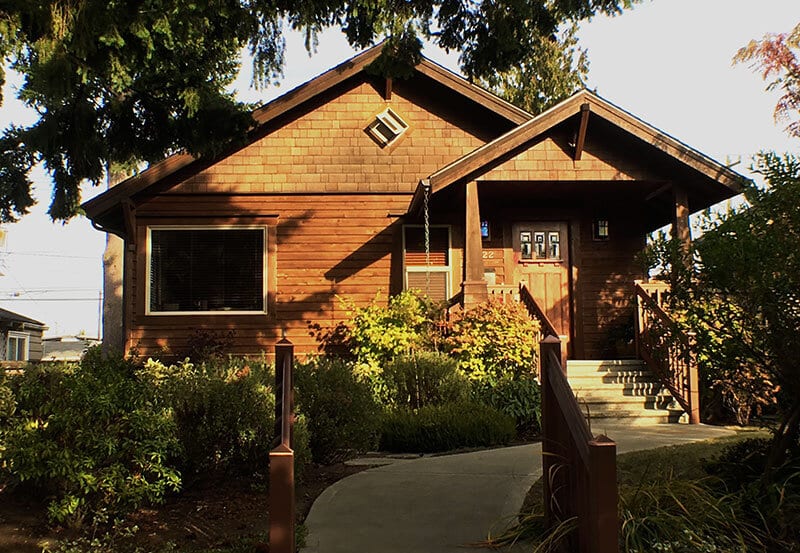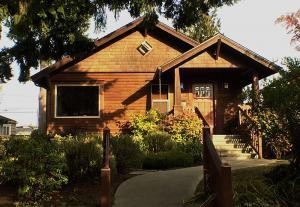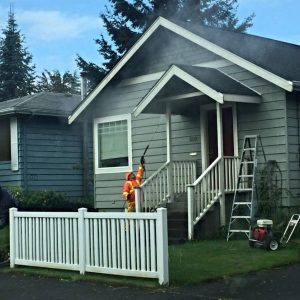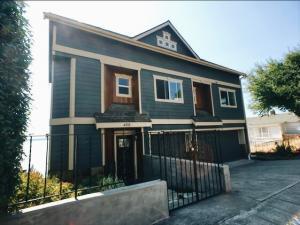(206) 258-6676

Home Siding Types: Pros & Cons
Cedar or other Wood Siding

With good upkeep, wood siding will last years and years. We recommend painting wood siding every 7-10 years and inspecting it on an annual basis to ensure there is no moisture intrusion or paint failure that will lead to further damage.
When you are ready to paint, be sure you work with a painting company that performs thorough exterior surface prep, especially in Seattle where moisture is a huge concern. Your exterior painter should also point out failing areas for you and be able to perform the necessary repairs. One drawback of wood siding is that it is also prone to paint bubbling or other application problems as the surface deteriorates — excessive moisture (from the outside or inside!) is the main cause of this. With a quality paint job, maintenance, and regular inspections/touch-ups, wood siding should stand the test of time.
Particularly for old cedar siding, you may wish to consider a solid-body stain instead of a paint, because the film coat doesn’t dry and pull as tightly. It is also more breathable. Both of these factors help avoid the dreaded bubbling. However, you must apply stain products more frequently than paint — between 4 and 6 years depending on the type/opacity of the stain.
Despite the upkeep requirements of wood siding, many homeowners opt to have wood siding on their home as there is nothing quite like the timeless, classic feel of wood. Wood siding also provides a good sound barrier and insulation. Some Seattle and Puget Sound homeowners with wood siding will opt for a stain rather than a paint (like in the photo above) to further accentuate and enhance the beauty of natural wood.
Vinyl Siding

If installed properly, vinyl can be the most low maintenance siding available. While the siding itself is water resistant, water can become trapped behind it if improperly installed or damaged. Vinyl siding is durable, but weather at either extreme can cause it to crack, chip or fade. One downfall of vinyl is that, if it is not in good condition, it cannot be easily repaired/resurfaced to prep for painting. Painting vinyl siding is generally acceptable if in good condition and washed/cleaned properly. Using a product specifically formulated for vinyl siding is recommended, such as Benjamin Moore Regal Select REVIVE. However, if the siding shows any sign of warping, buckling, or adhesion issues, we recommend you avoid repainting. Some siding manufacturers will not honor their warranty if the vinyl siding is painted, so this is also something to keep in mind.
Modern formulations and installation techniques for vinyl siding have vastly improved its performance and durability from its early days, making it a good option for your home if minimal maintenance is what you’re after.
Hardie-Plank

Named after its creator, James Hardie, hardie-plank looks like wood, but is actually a fiber cement siding product. Specifically, cement, sand, water, and wood fibers make up this product. We are seeing more and more hardie-plank siding in Seattle, and for good reason! This type of siding is very resilient to inclement weather that we often experience in the Northwest. It is also rot and insect resistant. It is even fireproof, quite unlike its wood and vinyl counterparts. Despite being of a different composition than wood, hardie-plank convincingly mimics the classic appearance of wood siding when painted.
The greatest drawback of hardie-plank is its cost. Due to its heavy weight compared to other sidings, its cost of installation can be significantly higher. However, it is nonetheless a great choice for resale, as homeowners can recoup much of the project costs upon sale (78-100%!) [x]. Another selling point for hardie-plank is that it is a green building material due to its sustainability, lack of toxic materials used in production, and sheer longevity.
Although it is generally low maintenance, we do recommend painting hardie-plank periodically (every 7-10 years).
Stucco
We sometimes see stucco or its synthetic counterpart, EIFS, on Seattle homes, although it’s more common in the Southwest. Stucco is composed of cement, lime, and silica built up multiple layers over wood or metal. Properly applied stucco is also sound-proof and fire-resistant. There is some debate as to whether stucco is the best option for our wet climate, due to its porosity.
EIFS can be even more susceptible to moisture intrusion and damage, as it is not breathable. EIFS is better suited for design elements such as archways and accents due to its flexibility and greater ease of installation. For either stucco or EIFS, we recommend a flat paint. The low sheen will not accentuate the rough texture that is characteristic of stucco. If you observe cracks/damage, we recommend consulting with a stucco repair company, as painting a damaged surface may trap moisture or exacerbate the problem. Also exercise caution when cleaning Stucco/EIFS, as high-pressure cleaning may cause damage.
Not sure about paint application for your siding? Contact a professional today! Sound Painting Solutions is a Seattle painting contractor with decades of cumulative team experience in exterior painting. We can recommend the best prep, application methods, and products for your home and siding type. We serve Seattle as well as the East Side area! Give us a call today at (206) 258-6676. You may also contact us via our form on the upper right-hand side of this page.



Comments
Thanks Lindsey! I will use Hardie planks in my new proyect on the second story! Photos coming soon!
Awesome! Can’t wait to see!
Thanks for pointing out that wood sidings must be painted every 7-10 years to make sure that they won’t easily get damaged due to moisture intrusion. This is something that I will remember because I’m planning to have new sidings installed for our house. My goal is to maintain the classic appearance of our house, so I’m particularly interested in wooden sidings. I will remember all your tips to save me money on repairs.
My house is looking a bit drab lately so I am trying to come up with some ideas in order to make it pop more, and look more appealing of course. Anyways, I do like how you have these four listed with their benefits and drawbacks. I’m leaning more towards vinyl given it is low maintenance and I’m all for that. I will do as you mentioned and regularly clean it off since I’m going to be going with a white exterior.
Nice Post! Thanks for sharing this informative Blog.
Good Job!:)